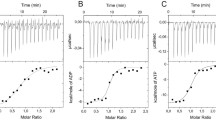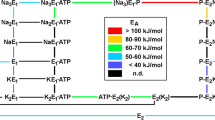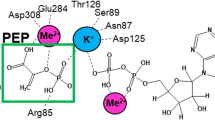Abstract
Selective treatment of pig kidney fructose 1,6-bisphosphatase with potassium cyanate leads to the formation of an active carbamylated enzyme that has lost the cooperative interactions among AMP sites, but retains sensitivity to inhibition of catalytic activity by the regulator AMP. Incorporation data on [14C]KNCO indicate that the loss of enzyme cooperativity at the AMP sites is related to selective carbamylation of four lysine residues per mole of tetrameric enzyme. Exhaustive carbamylation suggests that a second lysine residue per subunit is essential for AMP inhibition.
Similar content being viewed by others
References
Benkovic, S. J., and De Maine, M. M. (1982).Adv. Enzymol. Relat. Area Mol. Biol. 53, 45–82.
Benkovic, P. A., Frey, W. A., and Benkovic, S. J. (1978).Arch. Biochem. Biophys. 191, 719–726.
Colombo, G., and Marucs, F. (1973),J. Biol. Chem. 248, 2743–2745.
Laemmli, U. K. (1970).Nature 227, 680–685.
Maccioni, R., Hubert, E., and Slebe, J. C. (1979).FEBS Lett. 102, 29–32.
Marcus, F. (1967).Arch. Biochem. Biophys. 122, 393–399.
Marcus, F. (1976).Biochemistry 15, 3505–3509.
Marcus, F., and Hubert, E. (1968).J. Biol. Chem. 243, 4923–4925.
Marcus, F., and Haley, B. E. (1979).J. Biol. Chem. 254, 259–261.
Marcus, F., Edelstein, I., Saidez, L. J., Keim, P. S., and Heinrikson, R. L. (1981).Arch. Biochem. Biophys. 209, 687–696.
Riquelme, P. T., and Czarnecki, J. J. (1983).J. Biol. Chem. 258, 8240–8245.
Shen, W. C., and Colman, R. F. (1975).J. Biol. Chem. 250, 2973–2978.
Slebe, J. C., and Martínez-Carrión, M. (1976).J. Biol. Chem. 251, 5663–5669.
Slebe, J. C., Hubert, E., and Maccioni, R. (1978).Arch. Biol. Med. Exp. 11, R-214.
Slebe, J. C., Ojeda, A., Hubert, E., and Maccioni, R. (1981). InMolecular Approaches to Gene Expression and Protein Structure (M. A. Q. Siddiqui, M. Krauskopf, and H. Weissbach, eds.), Academic Press, New York, pp. 329–363.
Spackman, D. H., Stein, W. H., and Moore, S. (1958).Anal. Chem. 30, 1190–1206.
Stark, G. R. (1972).Meth. Enzymol. 25(B), 579–584.
Stark, G. R., and Smyth, D. G. (1963).J. Biol. Chem. 238, 214–226.
Taketa, K., and Pogell, B. M. (1965).J. Biol. Chem. 240, 651–662.
Tejwani, G. A. (1983).Adv. Enzymol. Relat. Area Mol. Biol. 54, 121–194.
Vita, A., Kido, H., Pontremoli, S., and Horecker, B. L. (1981).Arch. Biochem. Biophys. 209, 598–605.
Author information
Authors and Affiliations
Rights and permissions
About this article
Cite this article
Slebe, J.C., Herrera, R., Hubert, E. et al. Fructose 1,6-bisphosphatase: Dissociation of AMP cooperativity and AMP inhibition by carbamylation. J Protein Chem 2, 437–443 (1983). https://doi.org/10.1007/BF01025417
Received:
Published:
Issue Date:
DOI: https://doi.org/10.1007/BF01025417




